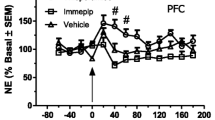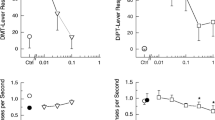Abstract
Head-twitch response (HTR) in mice was induced by intracerebroventricular injection of tryptamine (TRA) as well as serotonin (5-HT) and p-chloroamphetamine (PCA). Pretreatment with 5,7-dihydroxytryptamine enhanced both the 5-HT-induced and the TRA-induced HTR. The PCA-induced HTR, however, was attenuated by the drug. On the other hand, pretreatment with 6-hydroxydopamine did not alter the 5-HT response but enhanced both the PCA- and the TRA-induced response. These results suggest that 5-HT may directly stimulate the post-synaptic receptors, while the PCA response may be based on the release of endogenous 5-HT. The presynaptic component of the central serotonergic system does not appear to be involved in the TRA response. Both PCA and TRA may affect catecholaminergic systems which can suppress the response.
Similar content being viewed by others
References
Baumgarten HG, Björklund A, Lachenmayer L, Nobin A (1973) Evaluation of the effects of 5,7-dihydroxytryptamine on serotonin and catecholamine neurons in the rat CNS. Acta Physiol Scand [Suppl] 391:1–19
Brittain RT, Handley SL (1967) Temperature changes produced by the injection of catecholamines and 5-hydroxytryptamine into the cerebral ventricles of the conscious mouse. J Physiol 192:805–813
Burkard WP, Jalfre M, Blum J (1969) Effect of 6-hydroxydopamine on behaviour and cerebral amine content in rats. Experientia 25:1295–1296
Corne SJ, Pickering RW, Warner BT (1963) A method for assessing the effects of drugs on the central actions of 5-hydroxytryptamine. Br J Pharmacol 20:106–120
Fuxe K, Ogren S, Agnati LF, Jonsson G, Gustafsson J (1978) 5,7-Dihydroxytryptamine as a tool to study the functional role of central 5-hydroxytryptamine neurons. Ann NY Acad Sci 305:346–369
Gaddum JH (1953) Tryptamine receptors. J Physiol 119:363–368
Haeusler G (1971) Short and long term effects of 6-hydroxydopamine on peripheral organs. In: Malmfors T, Thoenen H (eds) 6-Hydroxydopamine and catecholamine neurons. North-Holland Publ, Amsterdam, pp 193–204
Haley TJ, McCormick WG (1957) Pharmacological effects produced by intracerebral injection of drugs in the conscious mouse. Br J Pharmacol 12:12–15
Irons J, Robinson CM, Marsden CA (1984) 5-HT involvement in tryptamine induced behavior in mice. In: Boulton AA, Baker GB, Dewhurst WG, Sandler M (eds) Neurobiology of the trace amines. Humana Press, Clifton, New Jersey, pp 423–427
Janssen PAJ, Niemegeers CJE, Schellekens KHL (1965) Is it possible to predict the clinical effects of neuroleptic drugs (major tranquillizers) from animal data? Arzneimittelforschung 15:104–117
Kellar KJ, Cascio CS (1982) [3H]Tryptamine: high affinity binding sites in rat brain. Eur J Pharmacol 78:475–478
Martin LL, Sanders-Bush E (1982) Comparison of the pharmacological characteristics of 5-HT1, and 5-HT2 binding sites with those of serotonin autoreceptors which modulate serotonin release. Naunyn-Schmiedeberg's Arch Pharmacol 321:165–170
Maxwell DR, Gray WR, Taylor EM (1961) Relative activity of some inhibitors of monoamine oxidase in potentiating the action of tryptamine in vitro and in vivo. Br J Pharmacol 17:310–320
Nakamura M, Fukushima H (1978) Effect of 5,6-dihydroxytryptamine on the head-twitches induced by 5-HTP, 5-HT, mescaline and fludiazepam in mice. J Pharm Pharmacol 30:56–58
Nygren L, Fuxe K, Jonsson G, Olson L (1974) Functional regeneration of 5-hydroxytryptamine nerve terminals in the rat spinal cord following 5,6-dihydroxytryptamine induced degeneration. Brain Res 78:377–394
Oldendorf WH (1971) Brain uptake of radiolabelled amino acids, amines, and hexoses after arterial injection. Am J Physiol 221:1629–1639
Orikasa S, Kisara K (1982) A possible mechanism of the tyramine-induced head-twitch response. Eur J Pharmacol 80:163–169
Orikasa S, Sakurada S, Kisara K (1980) Head-twitch response induced by tyramine. Psychopharmacology 67:53–59
Palmer GC (1972) Increased cyclic AMP response to norepinephrine in the rat brain following 6-hydroxydopamine. Neuropharmacology 11:145–149
Saavedra JM, Axelrod J (1973) Effect of drug on the tryptamine content of rat tissues. J Pharmacol Exp Ther 185:523–529
Sanders-Bush E, Gallager DA, Sulser F (1974) On the mechanism of brain 5-hydroxytryptamine depletion by p-chloroamphetamine and related drugs and the specificity of their action. In: Costa E, Gessa GL, Sandler M (eds) Advances in biochemical psychopharmacology: Serotonin: new vistas, vol 10. Raven Press, New York, pp 185–194
Schain RJ (1961) Some effects of a monoamine oxidase inhibitor upon changes produced by centrally administered amines. Br J Pharmacol 17:261–266
Shore PA, Pletscher A, Tomich EG, Carlsson A, Kuntzman R, Brodie BB (1957) Role of brain serotonin in reserpine action. Ann NY Acad Sci 66:609–617
Singleton C, Marsden CA (1981) Circadian variation in the head-twitch response produced by 5-methoxy-N1-N1-dimethyltryptamine and p-chloroamphetamine in the mouse. Psychopharmacology 74:173–176
Sloley BD, Hickie BE, Dixon DG, Downer RGH, Martin RJ (1986) The effects of sodium pentachlorophenate, diet and sampling procedure on amine and tryptophan concentrations in the brain of rainbow trout. Salmo gairdneri Richardson. J Fish Biol 28:267–277
Suchowsky GK, Pegrassi L, Moretti A, Bonsignori A (1969) The effect of 4-H-3-methylcarboxamide-1,3-benzoxazine-2-one (FI 6654) on monoamine oxidase and cerebral 5-HT. Arch Int Pharmacodyn 182:332–340
Sugimoto Y, Yamada J, Horisaka K (1986) Strain differences in the behaviour induced by tryptamine in five strains of mice. Neuropharmacology 25:1289–1291
Tedeschi DH, Tedeschi RE, Fellows EJ (1959) The effects of tryptamine on the central nervous system, including a pharmacological procedure for the evaluation of iproniazid-like drugs. J Pharmacol Exp Ther 126:223–232
Thoenen H, Tranzer JP (1973) The pharmacology of 6-hydroxydopamine. Annu Rev Pharmacol Toxicol 13:169–180
Trulson ME, Jacobs BL (1976) Behavioral evidence for the rapid release of CNS serotonin by PCA and fenfluramine. Eur J Pharmacol 36:149–154
Trulson ME, Jacobs BL (1978) Behavioral evidence for denervation supersensitivity after destruction of central serotonergic nerve terminals. Ann NY Acad Sci 305:497–509
Udenfriend S, Weissbach H, Bogdanski DF (1957) Biochemical findings relating to the action of serotonin. Ann NY Acad Sci 66:602–608
Ungerstedt U (1971a) Postsynaptic supersensitivity after 6-hydroxydopamine induced degeneration of the nigro-striatal dopamine system. Acta Physiol Scand [Suppl] 367:69–93
Ungerstedt U (1971b) Histochemical studies on the effect of intracerebral and intraventricular injection of 6-hydroxydopamine on monoamine neurons in the rat brain. In: Malmfors T, Thoenen H (eds) 6-Hydroxydopamine and catecholamine neurons. North-Holland Publ, Amsterdam, pp 101–127
Woolley DW, Shaw E (1953) Antimetabolites of serotonin. J Biol Chem 203:69–79
Author information
Authors and Affiliations
Rights and permissions
About this article
Cite this article
Orikasa, S., Sloley, B.D. Effects of 5,7-dihydroxytryptamine and 6-hydroxydopamine on head-twitch response induced by serotonin, p-chloroamphetamine, and tryptamine in mice. Psychopharmacology 95, 124–131 (1988). https://doi.org/10.1007/BF00212780
Received:
Revised:
Issue Date:
DOI: https://doi.org/10.1007/BF00212780




